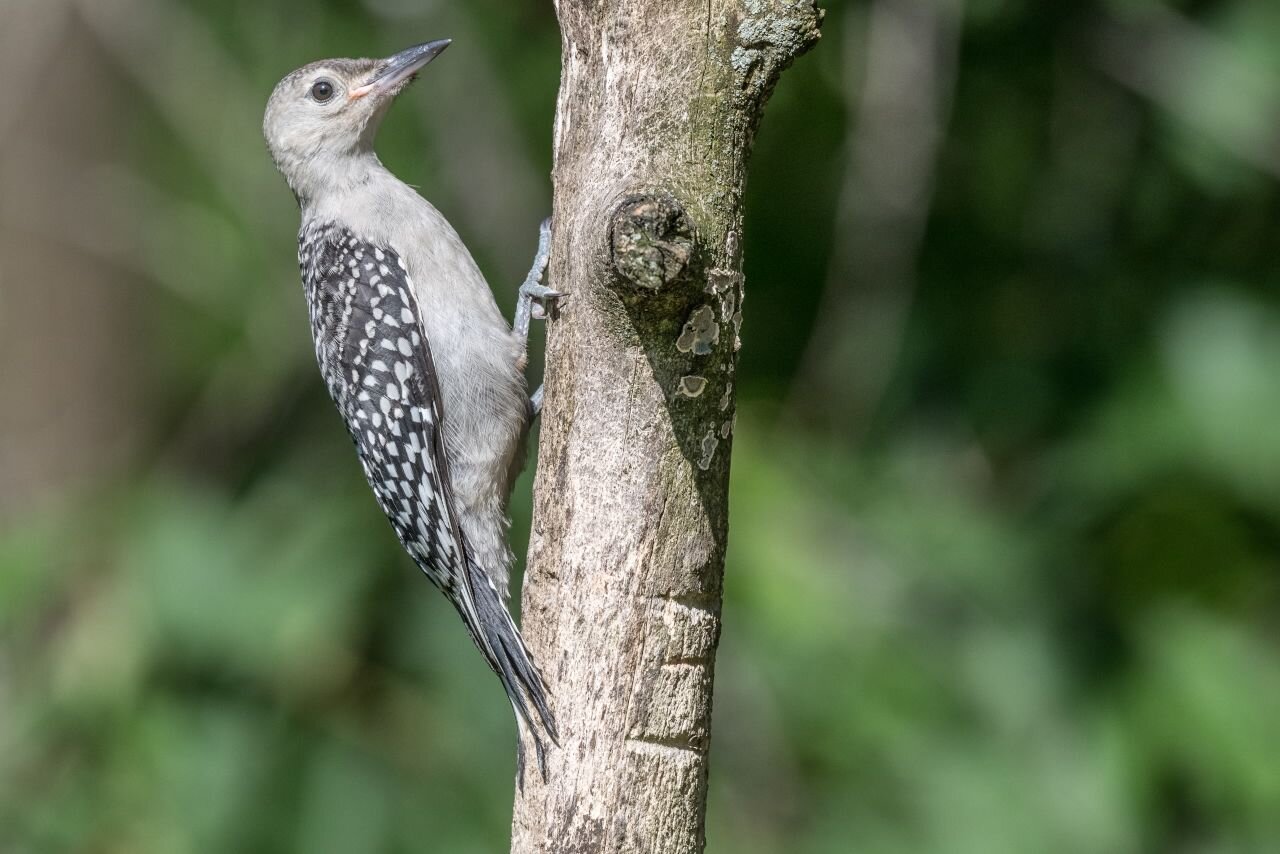Brown Thrashers
New life is always tremendously exciting. Jewel recently attended a virtual baby shower for our grand-niece who is expecting a baby boy shortly and even though all of the attendees could only share their excitement through the wonders of the Zoom app, there is no question all of the participants in the little boxes on the computer screen were thrilled with the prospect of a soon-to-be-born new family member. Undoubtedly the same is true with birds. They are extremely devoted and attentive caring parents and the little ones are well provided for.
A few years ago a pair of Northern Mockingbirds built a nest in one of Jewel’s tomato plants in her garden. The occasion gave us an opportunity to see the tremendous size of the gaping mouth the parent can’t help but find when it comes to feeding time (photo 2). The open mouth certainly appears as big as the entire baby itself. In addition, whenever Jewel went into her tomato plant to pick tomatoes, I had to stand guard with a broom as the parent birds would dive bomb Jewel (and me with the broom) trying to drive us away from the nest. It was amazing how fierce their attacks became.
Our Pennsylvania barn is a favorite nesting location as American Robins will sometimes pretend to be Barn Swallows and actually nest on the rafters just inside the open doors of the barn, but this year chose a spot on some old pallets that we didn’t dispose of quickly enough just outside the barn door (photo 3). And while the Barn Swallows build quite a number of nests inside the barn in an area we leave open for them, one year a pair built just outside the barn door on an exposed rafter making photographing them easy. (photo 4).
After the fledglings leave the nest the parents continue to feed them, often bringing them to our bird feeding station where plentiful food is available without the parents having to work too hard to find it, such as this Brown Thrasher parent feeding dried meal worms to one baby with another patiently waiting (top of page). Nevertheless, the babies continue begging for some time until they can feed themselves. Young Downy Woodpeckers don’t come to the ground but remain on a nearby tree as the parents grab a quick bite from the suet feeders and bring it to them (photo 5).
Young Red-bellied Woodpeckers learn to fend for themselves pretty quickly, but await their turn on the nearby tree before venturing over to the suet feeders. Note that the juvenile Red-bellied does not have a hint of the red either on the head or on the belly that gives the species its name (photo 6). A juvenile Northern Cardinal seeks the comfort of a nearby flowering tree after feeding, sometimes even leaving some food on its beak. “Will someone please get me a napkin?” (Photo 7)
One of the less pleasant duties of parenting is the dreaded diaper change. Human babies require constant attention to their waste disposal. Not surprisingly, the same is true for baby birds. However, instead of the chore of changing diapers (wouldn’t that be an interesting concept for birds) the hatchlings waste comes in a neat disposable fecal sac (photo 8) which the parent collects and drops after flying some distance from the nest. At our barn it seems that the Barn Swallows have decided that just outside the barn door is a good place to drop off the waste as a fair amount of it gets deposited right there thus requiring constant power washing of the area to keep it halfway presentable.
While the care and feeding of human infants continues for a couple of years, fledgling birds grow at a rapid pace and leave the nest anywhere from 12 to 26 days after hatching depending on the species and it is amazing to see how quickly they grow. Then the parents continue feeding them for only a few days out of the nest when the young are expected to have learned how to feed on their own.
With some species the parents get right back to work laying more eggs and raising a second brood the same year. Thus, in human terms young birds become teenagers in a matter of weeks. Human parents would probably shudder at the prospect of their children becoming teenagers at age 2 and have that period of their lives last for the next 18 years. Of course, as with birds they could probably kick them out of the nest at age 3 and tell them they are now on their own. I guess it probably is better to have it the way it is with human teenage years only lasting a relatively short three to five years, although it can sometimes seem like an eternity. Then too, man has always envied birds’ ability to fly. Does it sometimes seem we always want more and are never satisfied? “Oh for the life of a bird!” Really?
A number of Hart Beat readers have asked for more information about our feeding station setup. In photo 9, one can see the two dead holly trees on the left which serve as a launching spot for many birds, particularly woodpeckers. Moving right, there are three different types of block feeders, one with dried meal worms and bird seed, and two different types of feeders containing high protein suet formulated not to melt in the heat of summer.
Continuing right, next is the unsalted shelled peanut feeder, which is extremely popular with many species. The orange-colored feeder is the grape jelly feeder, which is frequented most by the Baltimore Orioles, Gray Catbirds, Northern Mockingbirds, and this year for the first time, an Orchard Oriole. Finally, on the far right are a number of black oil sunflower feeders. In another location we also have both a millet feeder popular with Chipping Sparrows and Indigo Buntings, and a Niger thistle feeder popular with American Goldfinches. Photo 10 shows my photography blind and what the birds see when I am in it, and photo 11 illustrates what a small part of our property the feeding station actually occupies.
The first Hart Beat Baby Birds column appeared in October 2012 and can be accessed at page 74 of the downloadable Hart Beat Book on the SLAS web site: https://static1.squarespace.com/static/5b9bd1b9697a984c75661b0f/t/5c3bc6556d2a73d481fa6116/1547421317715/HartBeatPart1.pdf. For more on the birth, growth and development of baby birds see: https://www.avianreport.com/altricial-precocial-birds/.










